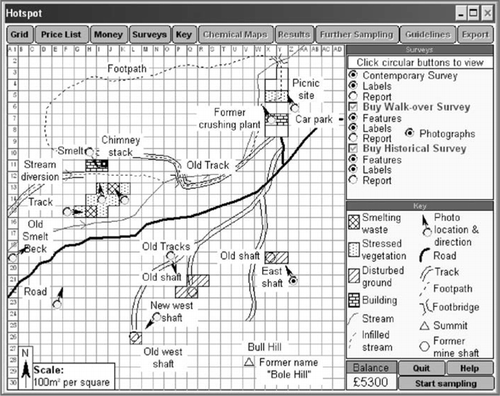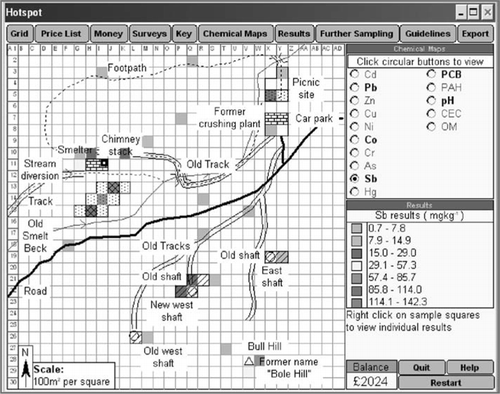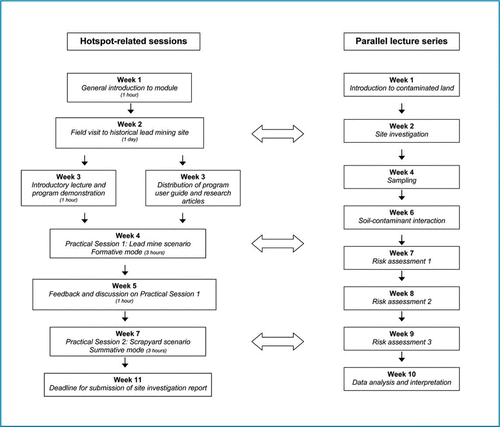Abstract
The Hotspot software was developed to simulate the preliminary stages of a site investigation of contaminated land. The simulation was introduced into Stage 3 of the BSc Environmental Science at the University of Plymouth in 2003. It built on an approach based on a real but limited investigation of an actual contaminated site. The main aim of introducing the simulation was to transfer more responsibility to the individual student for the design of the site investigation, particularly in relation to sampling and analytical strategy. This aim was achieved most effectively when Hotspot was implemented in a blended fashion alongside fieldwork and directed reading. A preliminary interpretation of student feedback indicates a positive response to the program and its form of implementation. The authors’ experiences of designing and developing the software are discussed and key elements for success are identified.
Introduction
The Environmental Science degree at the University of Plymouth is designed to deliver interdisciplinary knowledge and skills in this subject area. In common with other degree programs, the final year is particularly important for developing students’ ability to think for themselves, operate more independently, make decisions based on available evidence, make judgements based on an evaluation of data and information and to raise awareness of professional practice. These qualities are important to prepare students for a range of destinations and roles in the environmental sector.
The subject area of contaminated land requires knowledge of the full range of scientific disciplines encompassed within environmental science. It also spans the interface between scientific knowledge and professional practice, especially when considering the key elements of site investigation, risk assessment and remediation strategy. Other workers have indicated that a case study approach is perhaps the best way to bridge the gap between scholarly activity and the workplace (CitationMoles et al. 2005). Whilst real case studies may be hard to achieve without actual placements, the use of e-learning modes such as simulation, virtual field visits and models can contribute significantly. This has been shown specifically to be the case in the area of site investigation in environmental science, the geosciences and civil engineering (CitationMoran et al. 1997; Moles et al. 2005)
Why simulation?
Site investigation is a key element of the Stage 3 module ‘Reclamation of Contaminated Land’ on the BSc Environmental Science. Since the inception of this module in the academic year 1999/2000, the learning approach has been based on an investigation of a real contaminated site taken from the apparently inexhaustible supply of former mining areas in the south west of England. This approach comprised the following stages:
desk study of site characteristics and history with development of project plan
field visit with group-based collection of soils, waters and surface wastes
laboratory analysis of samples for selected heavy metals (to generate a collective dataset), and
data interpretation and report writing (undertaken on an individual basis)
It was recognised that certain limitations of this approach could be overcome through the use of a simulation that allowed a student to undertake an investigation of a virtual contaminated site. The advantages anticipated from this innovation were:
an increase in an individual student’s responsibility for the design of sampling and analytical strategies
a decrease in students’ time spent on repetitive tasks (such as sample preparation and analysis)
final reports would be based on a student’s own dataset
students would experience more than one type of site
Thus, the Hotspot software was designed to achieve these criteria and in particular to:
be based on sound pedagogic principles
provide an experience that resembled reality
develop knowledge and skills appropriate for site investigation
offer formative ‘practice sessions’ as well as opportunity for summative assessment
allow users to proceed at their own pace
be enjoyable, exciting and easy to use
The Hotspot Simulation
The software simulates the initial stages of an investigation of a contaminated land site. There are two virtual sites available, each of which has a unique topography, geology, climate, industrial history and pattern of soil contamination. The user has to identify the location of the most contaminated areas of the site (the ‘hotspots’) by devising a sampling and analytical strategy achievable within a fixed financial budget. Site information and surveys are available in the program to help with this task but cost money to acquire.
Ideally, the user should proceed through the series of stages defined below although the software allows these to be undertaken in any order:
a desk study of descriptive and historical site information
a simulated site reconnaissance or ‘walk-over’ survey ( overleaf)
a geochemical survey of contamination across the site by simulated sampling and analysis of surface soils ( overleaf).
export of results from the programme.
Hotspot can be used both in formative assessment mode in which a user can undertake any number of ‘practice’ site investigations and a summative assessment mode in which a user is allowed only one attempt at a site investigation and for which the financial budget is fixed.
Development
Software development began in 2000 initiated by a small grant through the Student Centered Learning Initiative at the University of Plymouth. Programming expertise was available through a central team of learning technologists at the university. Asymetrix Toolbook was selected as the authoring tool for Hotspot as this authorware had already been successfully used to create analogous applications (CitationSanders and Nimmo 2001). Hotspot was finished in 2003 and integrated into the undergraduate curriculum in autumn of that year. The completion of the software was delayed by various factors including the low level of funding, staff moves and other commitments and the need to update Hotspot to retain compatibility with a university wide operating system upgrade.
The virtual site scenarios represented are (i) an area of lead mining activity and (ii) a scrapyard. Design of the former scenario drew directly on earlier research undertaken by one of the authors (CitationMaskall and Thornton 1993). A programming strategy was adopted to create a reusable ‘shell’ into which different site scenarios could be ‘slotted’ with minimal reprogramming. Hotspot was initially developed with the mine scenario. Once this had been fully tested, the scrapyard scenario was incorporated (in about two days) and the reusability of the software was established. Having a second site scenario offered the opportunity to run a formative or ‘practice’ session in addition to a summative session. This was considered essential to allow students time to familiarise themselves with the software. As a way of making the simulation more engaging and realistic, it was decided to include an element of ‘game play’ by constraining the site investigation to a budget.
Implementation
Hotspot was delivered in a blended fashion alongside fieldwork and directed reading and supported by a parallel lecture series (). The real site visit was retained and was used to illustrate practical aspects of site investigation and to expose students to data generated by such a process. The real site visited was related to the virtual scenario used in the formative session. The simulation was demonstrated in advance of both practical sessions and students were provided with the user’s guide and research papers relevant to both scenarios. The summative session was undertaken under examination conditions with a strictly enforced time limit. Assessment was based on an individually written site investigation report using the maps and data exported from Hotspot.
Student Feedback
Evaluation of Hotspot was carried out in three phases (). In all cases, evaluation was designed to gain information on the (i) ease of use of the program and (ii) its educational value. Feedback was obtained through the use of questionnaires, observation and informal discussion. The questionnaires were designed to generate two sorts of data. Firstly, qualitative responses were gained by short answers to questions; and secondly, quantitative data was collected by responses to statements based on the Likert scale.
Table 1 Phases of user-testing in Hotspot evaluation
A preliminary interpretation of the results indicate the following:
Students found the software easy to use.
The virtual sites and data were considered to resemble reality.
Students agreed that Hotspot should be used in an assessment
Students agreed that use of the simulation should be accompanied by a field visit
After using Hotspot, a majority of students felt confident enough to undertake a real site investigation
The simulation added to (i) students’ knowledge of contaminant sources and pathways, (ii) students’ appreciation of the value of planning and (iii) students’ awareness of operating within a fixed budget
A more comprehensive presentation and discussion of these results will be included in a subsequent publication.
Conclusions and recommendations
It became clear during the process of developing Hotspot that several factors need to be considered when creating educational software. It is clearly important that the design is informed by the relevant theoretical principles but it is also crucial to anticipate how the software is to be delivered and how student performance is to be assessed. The original design criteria for the Hotspot simulation were achieved and this was confirmed by student feedback. It also proved relatively straightforward to reconfigure the program to run a second site scenario. As anticipated, introduction of the simulation modified the student experience to one requiring more strategic and evaluative thinking whilst the time undertaking repetitive tasks was reduced. In addition, using Hotspot did result in the responsibility for the design and implementation of the site investigation lying more with the individual student. The more capable students reacted to this by undertaking considerable preparatory reading prior to the summative practical session. One potential disadvantage of using simulated fieldwork is the loss of real field visits (CitationFletcher et al, 2003). However, we decided to deliver Hotspot in a blended fashion, retaining the real visit and linking it to the site scenario used in the formative practical session. Student feedback indicated that this was of benefit and whilst the simulation was found to be realistic, it was still very useful to experience a real site.
Copies of the Hotspot courseware are available free of charge from the authors and are accompanied by a user’s guide and staff guide. Programs written in Asymetrix Toolbook are unfortunately not web compatible but we will post you a CD upon request that will currently run with Microsoft Windows XP. If you use the program, we hope that you would provide us with feedback on its implementation and student responses. Further work is aimed at developing a web-based version of Hotspot for which a feasibility study is currently underway funded by the JISC Distributed E-learning Program and the HE Academy GEES Subject Centre. This is to be designed to allow scenarios from a range of scientific or cognate disciplines to be used in Hotspot.
References
- FletcherS., FranceD., MooreK. and RobinsonG. (2003) Technology before pedagogy? A GEES C&IT perspective. Planet Special Edition 5: pp. 52-55
- MaskallJ.E. and ThorntonI. (1993) Metal contamination of soils at historical lead smelting sites. Land Contamination and Reclamation 1: pp. 92-100
- MolesN., MortimoreR. and ThrowerA. (2005) A learning resource to support Masters-level training of geologists in professional practice. Planet 14: pp. 18-21
- MoranJ.A., LangdonN.J. and GilesD.P. (1997) ‘Can site investigation be taught?’ Proceedings of the Institution of Civil Engineers, 120: pp. 111-118
- SandersM., and NimmoM. (2001) Developing “Developing Field Sim’ Software to support Fieldwork. Planet 1: pp. 6-7


